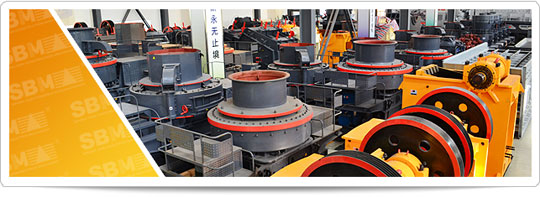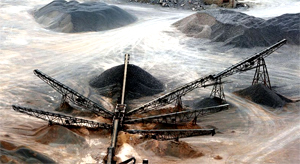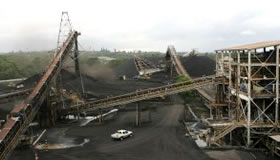-
Sand Making Crusher
- PCL-Vertical Shaft Impact Crusher
- SBM Hydraulic VSI Crusher
- VSI5X Series Impact Crusher

Coal Preparation Plant
Purposes of coal preparation

Coal preparation serves several purposes. One important purpose is to increase the heating value of the coal by mechanical removal of impurities. This is often required in order to find a market for the product. Run-of-mine coal from a modern mine may incorporate as much as 60 percent reject materials.
Air pollution control often requires partial removal of pyrites with the ash to reduce the sulfur content of the coal. Ash content often must be controlled to conform to a prescribed quality stipulated in contractual agreements. Because of firing characteristics, it is often as important to retain the ash content at a given level as it is to reduce it.
Freight savings are substantial when impurities are removed prior to loading. Finally, the rejected impurities are more easily disposed of at the mine site remote from cities than at the burning site, which is usually in a populated area.
Process Instrumentation
Instrumentation in the coal preparation plant is relatively simple in comparison with instrumentation at other process industries. The instruments generally found on coal preparation equipment are described below.
Belt Conveyor

The conveyors are driven by electric motors; the current drawn by the conveyor motors varies directly with the conveyor load. The ammeters located in the control room indicate the instantaneous current drawn by the conveyor motors. When excessive current is indicated, conveyor and equipment loading should be investigated. Some conveyors are also equipped with load meters. These meters indicate the percent of rated load carried by the conveyor at a particular instant. Ammeters and load meters give basically similar indications.
Coal Crushers
The crusher load is directly proportional to the feed rate and feed sizes. The crusher is driven by an electric motor. The ammeter for the motor is generally located in the central control room. Indication of excessive current should be investigated to determine the cause.
Vibrating Screens
In addition to the load-current ammeters, the screens may be equipped with pressure gauges indicating the pressure of water to the sprays. The various correct combinations of load current and spray pressure should be established during performance tests for reference during periodic inspections. The increase in load current would mean increased screen loading; this should be matched by increased spray water, which will be indicated by the pressure gauge.
Coal Preparation Process Description

As it leaves the mine, coal varies widely in size, ash content, moisture content, and sulfur content. These are the characteristics that can be controlled by preparation. Sizes range upward to that of foreign materials, such as a chunk of rock that has fallen from the mine roof or a metal tie;large pieces of coal from a very hard seam are sometimes included. Ash content ranges from three to sixty percent at different mines. Most of the ash is introduced for the roof or bottom of the mine or from partings (small seams of slate) in the coal seam. This ash, called extraneous ash, is heavier than 1.80 specific gravity. The remaining ash is inherent in the coal. The density of coal increases with the amount of ash present. The moisture content of the coal is also of two types. The surface moisture, that which was introduced after the coal was broken loose from the seam, is the easier to remove. This moisture is introduced by exposure to air, wet mining conditions, rainfall (in stockpiles), and water sprays. The remaining moisture, called “bed”, “cellular”, or “inherent” moisture, can be removed only by coking or combustion. This moisture was included during formation of the coal.
Foreign materials are introduced into the coal during the mining process, the most common being roof bolts, ties, car wheels, timber, shot s, and cutting bits.
Sulfur in coal occurs as sulfates, organic sulfur, and pyrites (sulfides of iron). The sulfates usually are present in small quantities and are not considered a problem. Organic sulfur is bound molecularly into the coal and is not removable by typical coal preparation processes. Pyrites generally are present in the form of modules or may be more intimately mixed with the coal. Coal preparation plants remove only a portion of the pyritic sulfur; therefore the degree of sulfur reduction depends on the percentage of pyrites in the coal, the degree to which this is intimately mixed with the coal, and the extent of coal preparation. All of the materials described above are combined with the coal to form the vibrating feed. Coal, as referred to above, denotes the portion of the feed that is desired for utilization.

- Capacity 40-60 TPH
- Capacity 100-120 TPH
- Capacity 150-180 TPH
- Capacity 200-250 TPH
- Capacity 300-350 TPH
- Capacity 350-400 TPH
- Capacity 500-600 TPH
- Capacity 600-800 TPH
- Capacity 800-1000 TPH
- Magnetite ore screening plant
- Coal Preparation Plant
- Sand Making Production Line
- Concrete Crushing Equipment
- Iron Ore Crushing Plant
- Coal Crushing Plant
- Aluminum Ore Crushing Line
- Cement Grinding Plant
- Construction Aggregate plant
- Antimony Ore Crusher Plant
- Gold Ore Crushing plant
- Nickel Crush Grinding Plant
- Aggregate Crushing Plant
- Track Ballast Production
- Gypsum Powder Line
- Australia Crushing Line
- Project from Hyman
- Project from Grover
- Project from Abbott
- Grinding line for USA
- Romania Crushing Line
- Russia Grinding Line
- Project from Joshua
- Ethiopian Potash Project
- Amessmessa Gold Project
- Gold Project for Ghana
- Project for Nigeria
- Project From Faida
- Project from CGO
- Project from Lucky
- Industrial Supplies for India
- Panama portable crushing project
- About Us
- |
- Service
- |
- News & Events
- |
- Contact Us
- |
- Resources
- |
- Showroom
Aggregate Crusher
Artificial Sand Making
Ballast Crushing Machine
Basalt Stone Crusher
Barite Mine Process
Beneficiation Plant
Bentonite Crusher
Bentonite Milling
Calcium Carbonate Crusher
Calcium Carbonate Grinding
Cement Grinding
Concrete Crusher
Coal Crusher
Copper Crusher
Cement Mill
Chrome Mining Process
Copper ore Beneficiation
Coal Processing
Coal Pulvarizer
Feldspar Crushing
Feldspar Grinding
Flotation Machine
Gold Crusher
Gold Mine Equipment
Gold Processing Machinery
Granite Crusher
Granite Crushing Machine
Granite Quarry Equipment
Gypsum Crusher
Gypsum Mining
Gypsum Powder Production
Iron Ore Beneficiation
Iron Ore Crusher
Kaolin Processing Plant
Limestone Crusher
Silica Sand Crusher
Iron Ore Mining Equipment
Cement Production Line
Talc Production Line
Quartz Crushing Machine
Limestone Mining Process
Manganese Benificietion























